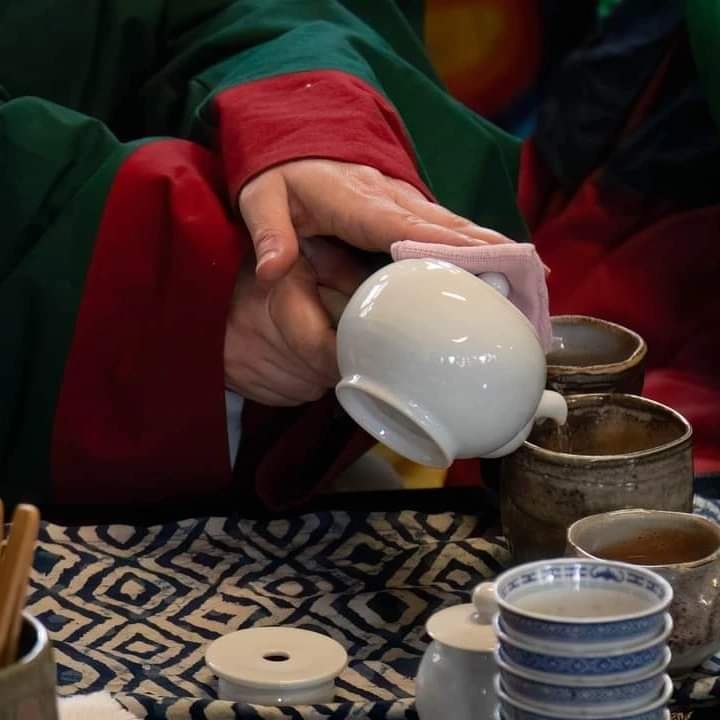by Wol Bi

China and Japan have cornered the market on the Western imagination of Eastern Tea Culture. So much so that The True History of Tea1has chapters for China, Japan, Russia and Europe, but three mentions2 in passing of “oh, there is tea in Korea too”. Despite this oversight, Korea has a long and varied practice of tea.
There are two legends about the origin of tea drinking in Korea. One links tea with the building of Buddhist temples in the 4th and 5th centuries. However, my favorite is that a princess of Ayodhya in India brought it with her when she followed her dream’s direction to marry Suro, the nine foot tall king of Garak, who hatched from a golden egg3. It is impossible to know exactly which, but I have an idea of which one is more likely, even if I like the other one better. Tea has been a part of Korean culture for a long time.
Tea preparation varies greatly over the centuries. A lot of people write poems and books about how to do it. Earlier centuries, most tea is produced via a long complicated process that ends with a cake of tea for storage. This tea is often roasted and reground in preparation to serve4. The loose leaf brew that is more familiar to us becomes popular in the 15th century5. This style is the easiest to recreate because sourcing tea cakes for the earlier styles made in the correct way is incredibly difficult, so recreation requires creativity6.
There are many kinds of tea ceremonies. From the elaborate ceremony that Xu Jing records for us in his 1126 account7 of his travels to Goryeo to the intimate ceremonies between friends or host and guests that the literati write poems about. There is always a reason for tea.
Korean tea tradition fades during the Joseon dynasty due to taxation on tea farmers, Japanese invasions and kidnappings of Korean potters and, finally, King Yeonjo shifts the ceremonies at that palace to use wine. The occupation of the peninsula by the Japanese really drove the Korean tea ceremony into obscurity, so much so that modernly, Koreans are known for their fondness of coffee8. Happily, there is a reviving interest in Korean style tea and lots of work has been done to reconstruct together a tradition from books written by Hanjae Yi Mok and others9, poems written by the literati, and accounts of tea ceremonies.
Outside of my interest in tea to match my persona, I find that the practice of Korean tea is personally more pleasing. Chinese tea has an aesthetic to it that I dare not attempt because I will drop that teaware and cry about it. Japanese tea is very formal and structured which I find restrictive. However, instead of explaining the concept of 망형 or manghyung, below is a presentation by Kim Donghyun, a Korean tea master:
If you see me at an event with my tea equipment, please come have a cup or two.
- The True History of Tea by Erling Hoh and Victor H. Mair ↩︎
- Yes, I counted them. ↩︎
- The Korean Way of Tea: An Introductory Guide by Brother Anthony of Taize and Hong Kyeong Hee ↩︎
- Korean Tea Classics by Hanjae Yi Mok and the Venerable Cho-ui and The Classic of Tea by Lu Yu ↩︎
- A Ming emperor actually makes it law that his tribute tea comes in loose leaf. Citation to come because I cannot remember which of the many books I have that it is from. ↩︎
- I have promised Choi Min a post on how to make tea like Lu Yu. Someday, I will be a better human and do it. ↩︎
- A Chinese Travel in Medieval Korea: Xu Jing’s Illustrated Account of the Xuanhe Embassy to Koryo The illustrations are lost to time, sadly. Hilariously, Xu Jing complains the tea is cold by the time anyone gets to taste it. ↩︎
- If you search the #scakorea on IG, it is allllllll fancy coffee. ↩︎
- Korean Tea Classics by Hanjae Yi Mok and the Venerable Cho-ui ↩︎
For more information, please visit Wol Bi’s site here.
